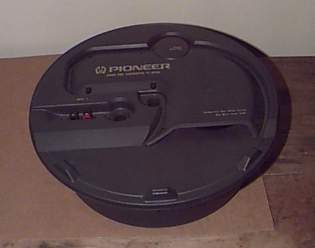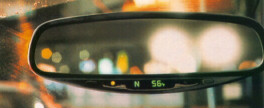
I managed to obtain a Pioneer Spare Tire Subwoofer (TS-WX50) for $30 since it's no longer in production. The idea of a subwoofer that fits into the spare tire appealed to me since I value my Integra hatchback's enormous cargo capacity (I've managed to fit a La-Z-Boy recliner inside with room to spare), but I desire improved bass response from the stereo. Having read reviews which were not positive about this subwoofer, I first tried it out by placing it in the spare tire and driving it with my home stereo receiver connected to the head unit's RCA outputs. It sounded surprisingly good considering it only has a 5.25" driver inside. While some car audio fanatics may turn up their noses at this unit, I feel it suits my purposes well since all I want is improved bass response at reasonable listening volumes. Neither concert quality sound reproduction nor building-shaking bass are necessary. What's more, the new Acura RSX, the Integra's replacement, comes with a Bose spare tire subwoofer as standard equipment, so I'm not the only one who thinks this is a good idea. If you're interested in purchasing a Pioneer spare tire subwoofer, I can only suggest Ebay, since it's rare and out of production.
 |
| Pioneer Spare Tire Subwoofer |
The problem I have with the subwoofer now is how to drive it. Most car
stereo amplifiers I've seen are either too powerful and expensive, or too
small. This subwoofer has a maximum continuous power rating of
Several manufacturers offer amplifier chips in this speaker's power range, but these chips require high voltage (50-100 V). Most higher-end car stereo amp manufacturers use special DC-DC convertors to boost the car's 12V to a voltage suitable for these amplifier designs. However, this also adds a lot to the cost and complexity of these units.
Fortunately, there's a chip available from Philips Semiconductor called the TDA1562Q. It's a class-H mono
amplifier made specifically for car audio applications. Volkswagen is even using
these chips in one of their new cars. The chip is rated at
Update: I found a website which includes schematics and a PC board layout for an amplifier using the TDA1562Q. The chip is also available for about $8.50 from Pioneer Electronics.
Update: I'm now considering just buying a stand-alone subwoofer amplifier. Many recent models are available on ebay for less than $50, which is probably not much more than I'd spend building my own.
Another project I've come up with is acquiring an electrochromically dimming rearview mirror and mounting it in my car. Such mirrors automatically darken when headlights strike them, removing the need to manually adjust the mirror depending on time of day. Even worse, my Integra's mirror doesn't go to the correct position when I flip the day/night lever, so I must completely re-adjust it to see properly. An auto-dimming mirror would save me from all of that.
 |
| Donnelly ECT mirror |
Currently, there are two mirrors available in the aftermarket which I would consider. One is from Gentex, and the other is from Donnelly Electronics. Both of these manufacturers offer auto-dimming mirrors which also include two very useful features: an electronic compass and an outside temperature gauge.
The Gentex NVS mirror is currently sold through several distributors, most notably J.C. Whitney, but the price is $220, which is a little steep in my opinion. Donnelly's mirror is available directly from the manufacturer for only $199. Another, possibly less expensive alternative, is to get such a mirror from a salvage vehicle. I believe Donnelly mirrors are found on some Ford vehicles, and the Gentex mirror was sold as standard equipment on the Yukon, Denali, Tahoe, and Suburban SUV models from GM. Unfortunately, finding one of these vehicles in a junkyard is an extremely rare event, supposedly because the wrecks are purchased and rebuilt rather than salvaged, due to their ridiculously high sticker prices. It still befuddles me as to why such a high-tech mirror is sold on such low-tech vehicles.
Before you buy one of these mirrors for your Integra, however, be aware that no known method currently exists for mounting either of these aftermarket mirrors to the Integra's mounting arm, which connects the mirror directly to the car's roof. Unfortunately, in American tradition, these manufacturers stuck with the popular but curious method of gluing the mirrors to the windshield. And I've been told by a manager at Donnelly that at-home attempts to dismantle their mirror in the hope of mounting it to a roof-mount arm like the Integra's have resulted in complete failure. Since I don't intend to leave the roof mounting location bare in my car, I've put on hold plans for purchasing one of these mirrors. Maybe if I can get one cheap from a junkyard I can devise a solution...
Update: I got to try out one of Gentex's NVS mirrors in a $50,000 Cadillac Seville STS, and it actually makes cheap-plastic creaking noises when you handle it. What a piece of crap! (Actually, the rest of the Cadillac has this same feel. I've driven a BMW 3-series and a Mercedes S500, and I don't see how Cadillac hopes to compete with these makes when their car has such poor build quality. The German cars were rock-solid.) The mirror in my Integra feels and sounds very solid, unlike the American-made Gentex unit. I'll try to find a Donnelly mirror to inspect hands-on before I spend any money on one, but this really gives me second thoughts about adding any American OEM equipment to my car.
Update: After having 15% VTL tint installed in my rear window, I don't even use the night setting on my rear-view mirror any more, so I'm not sure an auto-dimming mirror would be of any use. The compass and temperature displays would still be helpful, though.
One problem I've contemplated is how to avoid being caught in speed traps. Currently, I see two routes to help reduce this problem: radar detectors and police scanners. I already have a Uniden Bearcat police scanner, which you can read about on the Interior Mods page.
 |
| Whistler 3300 ci radar detector |
A radar detector, in conjunction with the Bearcat scanner, should prove to be a very effective defense against "the speeding tax." If you're unfortunate enough to live in Virginia or Washington, D.C., radar detectors are somehow illegal (in defiance of the Federal Communications Act of 1933), and a more stealthy approach is necessary than simply keeping a detector on the visor. I've sinced moved out of Virginia to the much freer state of Arizona, so this isn't such a large concern for me anymore, but for aesthetic reasons, and to avoid theft, a stealthy solution would still be nice.
While many motorists tout the Valentine One detector as the very best, it only offers a "remote display" option which consists of turning off all the lights on the main unit's display and instead using an alternative remote display. But since the detector itself still must be mounted on the visor or windshield, it could be easily spotted by a cop and earn you a ticket.
 |
| K40 SS3000SWL (about $1500 installed!) |
Other companies, including BEL, Whistler, Escort, and K40, make "concealed display" units which divide the radar detector into several parts: the antenna/detector unit(s) and the display. With these systems, the detector is placed behind the front bumper where it can receive signals but not be discovered without a thorough search of the engine compartment. The display is placed wherever the user wishes, which allows for very creative installations. According to a review of all currently available remote-mount radar detectors at www.radartest.com, most units seem to perform similarly, even though they vary widely in price.